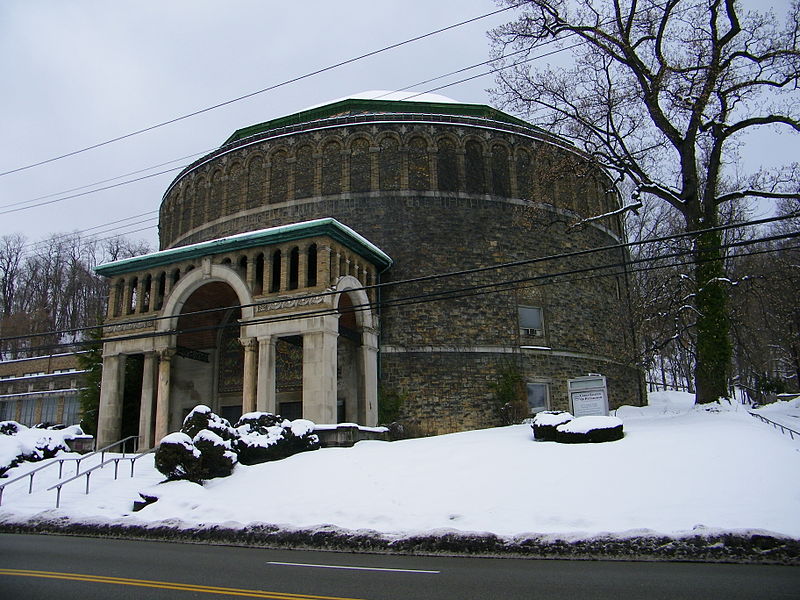Since moving to Pittsburgh, I’ve been thinking a lot about historic preservation. Everything here is old–from the house we bought to the streets to the infrastructure (see: falling apart Greenfield Bridge. Thanks for the press CBS!). And there are an enormous number of former churches and religious buildings that have been both preserved and repurposed, in a way that I had not seen much of in the South. This makes sense, right? In the Triangle, the population is growing rapidly and there’s lots of space, so you see storefront churches and megachurches and new religious buildings all of the time. Pittsburgh, while it may be currently on the rise, has suffered from population loss and as congregations dwindle, folks must decide what to do with the buildings they once used.
In our neighborhood alone, Highland Park, there are several examples of religious buildings that have been repurposed, many of them former synagogues.
This is perhaps one of the most impressive buildings, now used as a charter school by the Urban League of Pittsburgh.
Other synagogues in the neighborhood have been put into private use. The one below, Torath Chaim, was the last to close in Highland Park and is now in use as an artist’s studio. This Pittsburgh Post-Gazette article shows some interior pictures from more recent years, while some from 1980 are available at the Rauh Jewish Archives of the Heinz History Center.
Others in the area are now, as far as I can tell, private homes.
And of course, there is the Union Project a former church now realized as community space for art classes, yoga, gallery shows, and more.
Highland Park is one of many neighborhoods in Pittsburgh where these transformations are taking place. Neu Kirche is a Northside gallery slated to open soon, housed in a former Methodist Church. There are hotels, restaurants/breweries, and even the Altar Bar and Mr. Small’s Funhouse, where you can catch some decidedly unholy [musical] acts. Depending on where you live, seeking out this type of reuse could be an interesting class activity. What does it say about population changes or religious communities in the area? About changing values within the urban landscape?
Using the built environment like this also encourages students to really consider the meaning and symbolism in the buildings themselves. Does a congregation, in any religion, need a building to create space for worship? Or can the community itself create that space. Judaism answers this with a hard and fast rule–all you need is ten adult Jews to make a space fit for public worship–nothing is said about the state of the building. In other religions, there may be no set number, but the facility is often secondary to the people that would use it. (Are there exceptions to this in certain faiths?)
Generally, I like these examples of creative reuse. In most cases, they allow the buildings to continue to serve as community meeting places and often act as shelters for new projects and new ideas. But, this could also be a point of discussion among students. Is it right to use old religious buildings for certain purposes (a bar, for example)? Is commercial development in these formerly sacred spaces in poor taste?
Some additional resources I found regarding reusing religious spaces:
- Partners for Sacred Spaces is an organization dedicated to helping congregations determine what to do with their buildings and how to best preserve them
- Repurposing Dying Churches by Ministry Matters argues for using development or repurposing as a way to save buildings and congregations–some spaces can be used part-time for worship and part-time for other activities
- Hagia Sophia, the original example of repurposing. Might be useful in making the point to students that this is not necessarily a new idea.
- A fancy modern architecture version that is just beautiful to look at.
- And an opposing point of view, if you want to discuss why some people might be against the redevelopment of sacred spaces.





